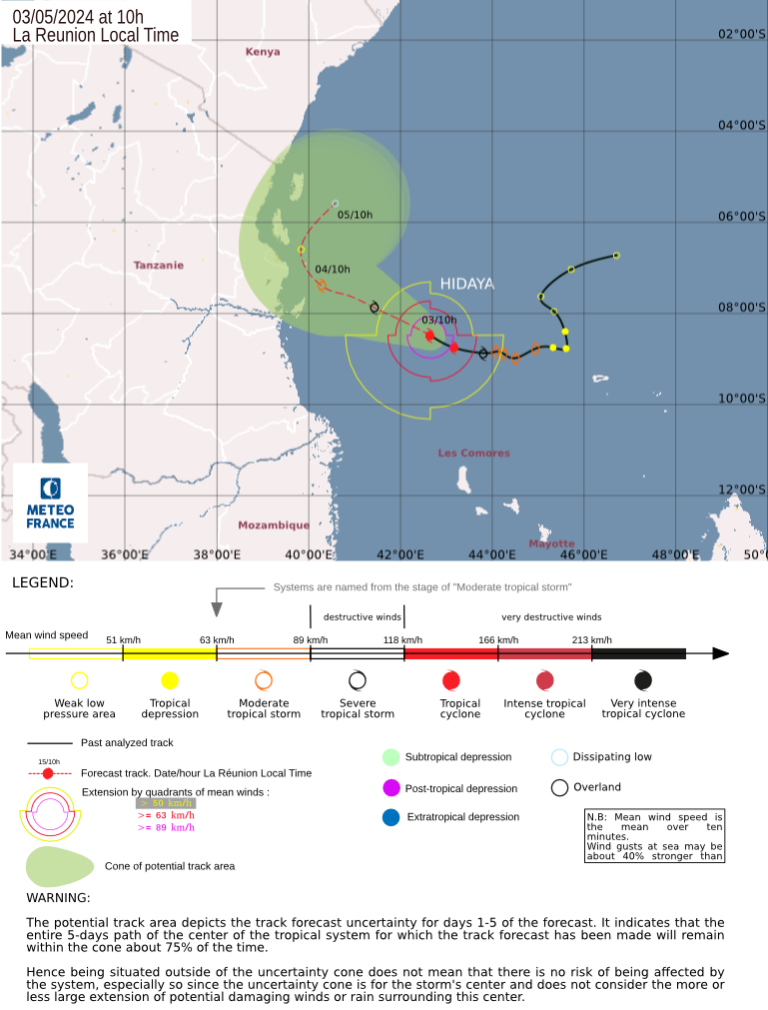CLIMATE CRISIS
Kenya on alert as it braces for first-ever cyclone
Kenyan President William Ruto put the flood-ravaged country on high alert on Friday and postponed the reopening of schools indefinitely as the nation braced for its first-ever cyclone.
Torrential rains have lashed East Africa since March and claimed the lives of more than 350 people.
The region is now threatened by a cyclone projected to make landfall at the weekend along its Indian Ocean coast.
“This cyclone named Hidaya, that could hit anytime now, is predicted to cause torrential rain, strong winds and powerful and dangerous waves,” Ruto told a press briefing in the capital, Nairobi.
“Our country must act swiftly and decisively to mitigate the devastating impacts of the present crisis and protect life and property.”
Schools, which were due to reopen on Monday, will now remain shut indefinitely.
All ministers have been directed to coordinate the evacuation and relocation of all affected Kenyans.
Cyclone Hidaya will peak at gusts of 165 kilometres (100 miles) per hour when it makes landfall in neighbouring Tanzania on Saturday, according to the Climate Prediction and Applications Centre for East African trade bloc IGAD.
Cyclone season in the southwest Indian Ocean normally lasts from November to April, and there are around a dozen storms each year.
Tanzanian authorities warned earlier on Friday that Hidaya had “strengthened to reach the status of a full-fledged cyclone” by 3:00 am (0000 GMT), when it was some 400 kilometres (250 miles) from the southeastern city of Mtwara.
“Cyclone Hidaya has continued to strengthen further, with wind speeds increasing to about 130 kilometres per hour,” they said in a weather bulletin.
– ‘No corner spared’ –
East Africa’s rains have been amplified by the El Nino weather pattern — a naturally occurring climate phenomenon typically associated with increased heat worldwide that leads to drought in some parts of the world and heavy downpours elsewhere.
So far, around 210 people have died in Kenya from flood-related incidents.
More than 165,000 others have been uprooted from their homes and nearly 100 are missing, according to government data.
“No corner of our country has been spared from this havoc,” Ruto said.
“Sadly, we have not seen the last of this perilous period,” he warned.
At least 155 people have been killed in Tanzania by floods and landslides that have destroyed crops and swallowed homes.
Rescuers in boats and aircraft have raced against the clock in pouring rain to help people marooned by the floods in Kenya.
In dramatic footage shared on Wednesday, the Kenya Red Cross rescued a man who said he was stranded by floodwaters and forced to shelter in a tree for five days in Garissa in the east of the country.
The military also joined search and rescue efforts after Ruto deployed them to evacuate everyone living in flood-prone areas.
The government has ordered anyone living close to major rivers or near 178 “filled-up or near filled-up dams or water reservoirs” to evacuate the area within 24 hours.
Opposition politicians and lobby groups have accused the government of being unprepared and slow to respond to the crisis despite weather warnings.
– Forced to escape again’ –
The heavier than usual rains have also claimed at least 29 lives in Burundi.
Some 175 people have been injured and tens of thousands displaced since September, the United Nations said.
UN refugee agency UNCHR said it was “particularly concerned” about thousands of refugees who had been displaced in Burundi, Kenya, Somalia and Tanzania.
“(They are) being forced to escape once again for their lives after their homes were washed away,” UNHCR spokesperson Olga Sarrado Mur said on Friday.
Late last year, more than 300 people died in rains and floods in Ethiopia, Kenya and Somalia, just as the region was trying to recover from its worst drought in four decades.
by Hillary ORINDE
President William Ruto outlines urgent measures to deal with floods across country
Andrew Wasike |03.05.2024 -

NAIROBI, Kenya
The death toll from floods in Kenya has risen to 210, said Kenyan President William Ruto on Friday during an address from State House in Nairobi.
"The weight of tragic events in recent weeks has tested our nation's resilience in the wake of unprecedented challenges," said Ruto, cautioning that Kenya may face its first-ever cyclone this weekend.
He said that Cyclone Hidaya is predicted to bring torrential rain, strong winds, and dangerous waves.
In response to the crisis, Ruto directed the Ministry of Education to postpone the reopening of all schools for the second term until further notice.
The president also instructed the Ministry of Interior to coordinate the relocation and evacuation of affected residents, identify temporary shelter sites, and oversee support programs.
To bolster disaster response and mitigation efforts nationwide, the Treasury Ministry has been tasked with providing adequate resources and collaborating with development partners to procure and distribute essential supplies such as food and medical items.
The Kenyan president also warned that the situation could worsen as water levels in the Seven Forks Hydro-Electric power dams, including Masinga and Kiambere, have reached historic highs, threatening to overflow into neighboring settlements in Garissa and Tana River counties.
He urged citizens to support ecosystem restoration efforts, including the ambitious plan to plant 15 billion trees nationwide within the next decade.
WMO NEWS
03 May 2024
Devastating flooding in East Africa is claiming an increasing number of casualties, destroying infrastructure and crops and killing livestock and wildlife. An incoming tropical cyclone is set to worsen the situation by bringing yet more heavy rainfall to the worst affected countries, including the United Republic of Tanzania and Kenya.

Credit: Copernicus EC Sentinel2 satellite
Kenyan President William Ruto addressed the nation, outlining a series of measures to deal with the emergency, including evacuations and urgent health provisions. Water dams are overflowing, roads and bridges have been destroyed, and schools are closed. As of 3 May, 210 people have been killed and many more injured, he said.
“No corner of our country has been spared from this havoc,” said President Ruto. “Sadly, we have not seen the last of this perilous period as this situation is expected to escalate. Meteorological reports paint a dire picture. The rains will persist, increasing both in duration and intensity for the rest of this month and possibly after,” he said.
The ongoing disaster underlines yet again the vulnerability of society to weather, water and climate-related hazards and the need for Early Warnings For All.
The waning El Niño event, alongside a phenomenon known as the Indian Ocean Dipole, and high sea surface temperatures are playing a role. But the excess energy trapped in the atmosphere and ocean by human-induced greenhouse gases is also having a major influence by turbo-charging the extreme weather.
“The current unprecedented crisis of floods that our country is experiencing …. is a direct consequence of our failure to protect our environment, resulting in painful effects of climate change. Our country will remain in this cyclical crisis for a long time unless and until we confront the existential threat of climate change,” said President Ruto.
The Kenya Meteorological Department issued numerous Red Alerts.

WMO’s Regional Specialized Meteorological Centre La Reunion issued advisories about Tropical Cyclone Hidaya
WMO’s Regional Specialized Meteorological Centre La Reunion and the Tanzania Meteorological Agency issued respectively advisories and warnings about Tropical Cyclone Hidaya. which is the first documented system to have reached tropical cyclone status in that low latitude region, making it historically significant for the northwestern corner of the South-West Indian Ocean basin.
Hidaya is forecast to bring dangerous waves and heavy rainfall to already sodden soils in Tanzania and also impact northern Mozambique. It is expected to skirt the coastline of those countries for the next couple of days while gradually weakening.
Other countries in the region have also been badly hit, including Uganda, Burundi and parts of Ethiopia and Somalia. This has worsened the already fragile humanitarian situation and displacement crisis in the Horn of Africa.
EXPLAINER
Government criticised over poor infrastructure as 210 people killed, thousands displaced and a cyclone is on the way.




